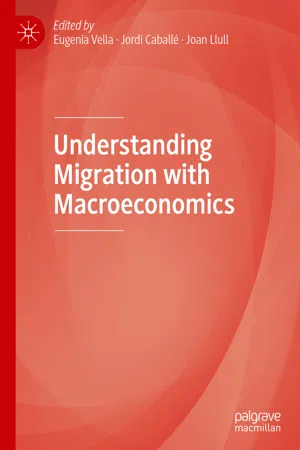The UK Independence Party (UKIP), the Front National party led by Marine Le Pen in France, and the Alternative für Deutschland party in Germany all gained prominence in their respective countries with anti-immigration platforms. Anti-immigration positions have underpinned, among others, the Brexit vote in 2016 in the UK and policies of the Trump administration in the United States. In sending countries, such as Southern and Eastern European countries, emigration has been a public concern, too.
In parallel to this political importance of migration, the economics of migration has developed as a major research field (see e.g. the books by Zimmermann and Bauer 2002; Mueller and Mills 2013; Borjas 2014; Chiswick and Miller 2014; Bansak et al. 2015; Borjas et al., 2019; Borjas and Chiswick 2019). There exists an extensive amount of academic work on the microeconomic aspects of migration. Yet, there is still a shortage of books specifically dealing with the macroeconomics of migration, even though there are macroeconomic factors that can help to explain why migration has become such a debated and contentious topic. Natives often view immigrants as posing threats to jobs and driving down wages. There is also the view that immigrants are a fiscal drain for the host economy, especially when, unable to secure a job, they benefit from public services without contributing. Natives also have a tendency to perceive unemployed immigrants as indulging in illegal and criminal activities. Conversely, others recognise that immigrants help the host economy grow through a variety of channels: by providing a different set of skills and being complementary to the local labour force, by easing labour supply shortages, and by stimulating aggregate demand in the economy through their demand of goods and services. The fiscal contribution of immigrants is more significant when immigrants are younger than natives, especially of working age, and occupy high-skilled positions.
In the economics of migration, there is already a number of studies with a microeconomic focus. Topics of interest include the effects of migration on wages and employment, both for immigrant and native workers (e.g. Borjas 2003; Ottaviano and Peri 2012; Dustmann et al. 2010), the impact of immigration on public finances (e.g. Borjas 1999; Storesletten 2000; Dustmann and Frattini 2014), on productivity (e.g. Peri 2012), on prices and the composition of demand (e.g. Lach 2007; Cortes 2008), and on house prices (e.g. Saiz 2003; Sá 2014). Yet, the links between migration and macroeconomic aggregates, such as per capita GDP, remain little explored.
This book aims to fill this gap by providing a brief but multifaceted overview of the macroeconomics of migration as a research field. This book is an edited collection of, but not limited to, contributions from participants in a workshop on the macroeconomics of migration that took place at the University of Sheffield in June 2018. The chapters analyse, both empirically and theoretically, the challenges that international migration poses both for sending and receiving countries. They touch upon several current debates related to the labour market effects of migration for natives, taxation and emigration, migration and the informal economy, migration and business cycles, and brain waste. This book thus provides a first step to a comprehensive synthesis of the macroeconomics of migration. In addition, this book aims to connect the macroeconomics of migration with the rest of the field of migration studies. To this end, the last chapter, which is co-authored by a historian and a political scientist, evaluates the new insights that this book offers for the other disciplines in that field, including history, sociology, and political science. This chapter also offers suggestions on the way to enhance further interdisciplinary collaboration between macroeconomics and other disciplines in the field of migration studies. The authors of the volume include both academics from several countries—including the UK, France, Spain, Austria, Greece, and Cyprus—as well as practitioners from the Central Bank of Ireland and the New South Wales Treasury in Australia. Finally, the book targets not only academics, but also practitioners and policymakers who wish to take a closer look at the macroeconomic effects of migration and learn about the current challenges posed by immigration or emigration.
This introductory chapter offers an overview of the recent migration trends by focusing on European countries for two reasons. Firstly, there has been a gradual convergence in labour mobility between Europe and the United States in recent years, reflecting both a fall in interstate migration in the United States and a rise in the role of migration in Europe (Beyer and Smets 2015). Secondly, the literature on Europe so far is less developed than the literature on the United States. This chapter then summarises the state of the art in the macroeconomics of migration up to now, before synthesising the findings of the various chapters included in this volume.
1.1 Recent Migration Trends in European Countries
Based on data from Eurostat, this section highlights three recent migration trends in Europe.1 First, the share of immigrants increased between 2009 and 2017 in the 15 older European Union (EU) member states, with the exception of peripheral countries. Second, following the unfavourable socioeconomic conditions created by the Great Recession and subsequent debt crisis, many peripheral countries shifted away from being host countries to being sender countries. Third, although immigrants tend to be younger compared to natives, their level of educational attainment relative to that of natives varies among the EU15 countries.
According to the data for 2017 presented in Fig. 1.1, Austria displays the largest share of immigrants (i.e. foreign-born) in its population among the EU15 countries.2 Nearly 19% of Austria’s population are foreign-born, with just under half of them born in the European Economic Area (EEA).3 In the UK, immigrants amount to around 14% of the population. The share of EEA immigrants in the overall British population equals 5.5%, that is nearly 40% of immigrants. In G...
